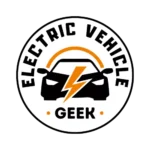Smart EV charging solutions use advanced technologies and intelligence features that leverage data and insights to optimize and personalize your electric vehicle (EV) charging processes to increase energy efficiency and reduce your EV charging costs.
How Does Smart EV Charging Work in Practice?
Let’s walk through the process of Smart EV Charging by referring to the Smart EV Charging features as shown in the infographic image below:

The first step in Smart EV charging involves connecting the smart EV charger to the grid, as shown in the Smart EV charging infographics image above; the grid can be connected to your existing electrical grid using a rectifier and a DC converter or renewable energy electricity grid such as those of Electrify America’s which is the leading electric vehicle charger that uses 100% of its electricity from renewable energy.
A typical electric vehicle grid integration will connect several smart EV charging stations through a grid management system that connects the EV owner and the electric grid technologies, policies, and strategies to meet its EV smart charging goals.
The grid management system integrates with bidirectional charging stations, Managed charging, Vehicle-to-grid (V2G), or Smart grid integration. The most common connection for home EV charging connections with the grid management system is the use of CT Clamp, as shown in the Smart EV Charging diagram above, which allows dynamic load balancing using intelligent power adjustment and load management to help in energy distribution among charging stations.
The CT Clamp allows the smart EV charging environment to adapt to variable Time of Usage (ToU) electricity tariffs that might arise during your EV charging processes, saving on the electricity costs of charging your EV.

At the heart of a Smart EV charging system is the Smart EV Charging station that charges the electric car and also connects to the grid management system, smart charging controller, and advanced remote monitoring infrastructure.
As shown in our EV charging scheduling chart below, we manage and schedule our EV charging through the Enphase App.

Our Enphase IQ EV Charger starts charging at the start of super off-peak hours at around midnight; However, when we arrive home at 6 pm and plug in our EV to the smart charger, the charger will not start charging until off-peak hours (midnight), by the time we wake up at 6 am the EV battery is fully charged.
Smart EV charging stations incorporate cutting-edge communication modules (Wifi, Bluetooth, or GSM) and sensors that are essential to the smart EV charging framework to enable communication and data transfer between the grid management system, smart charging controller, and advanced remote monitoring infrastructure through the monitor center, web application or an application.

A connected network of smart EV charging infrastructures must be established on an optimized smart EV charging system using the Standardised Communication Protocols for EV charging infrastructures ( IEC 63110 and ISO 15118), which have led to the growth of smart EV charging communication protocols such as open charge point protocol (OCPP) that enables communication in an EV charging environment, such as the grid capacity, dynamic load management, energy prices, supply of energy and user preferences to the grid management system.
Modern EV chargers allow Smart EV Charging Network Connectivity using Wifi, Cellular connectivity, and Bluetooth to connect smart EV charging hardware and software such as the charging station, smart charging controller, central management system, etc, allowing seamless data exchange.

Smart EV Charging Network Connectivity in a smart EV charging system provides real-time data exchange between smart EV charging hardware and also provides actionable insights such as automated billing, advanced remote monitoring, and other digital services such as status, rate, and usage reports for EV drivers.
Is a Smart EV Charger Worth It?
For businesses using smart EV DC Chargers, smart charging leads to increased customer traffic, revenue from charge points, and energy cost savings. It also ensures control over energy capacity, avoiding peak pricing charges, especially for businesses that own fleets of vehicles; smart charging guarantees vehicles have sufficient energy for their routes.
Individual EV drivers who use smart Level 2 AC Chargers enjoy cheaper, eco-friendly, and safer charging, with added benefits for those with home-based renewable energy systems.

James Ndungu is a certified EV charger installer with over five years of experience in EVSE selection, permitting, and installation. He holds advanced credentials, including certification from the Electric Vehicle Infrastructure Training Program (EVITP) and specialized training in EV charging equipment and installation, as well as diplomas in EV Technology and Engineering Fundamentals of EVs. Since 2021, James has tested dozens of EV chargers and accessories, sharing expert insights into the latest EV charging technologies.







